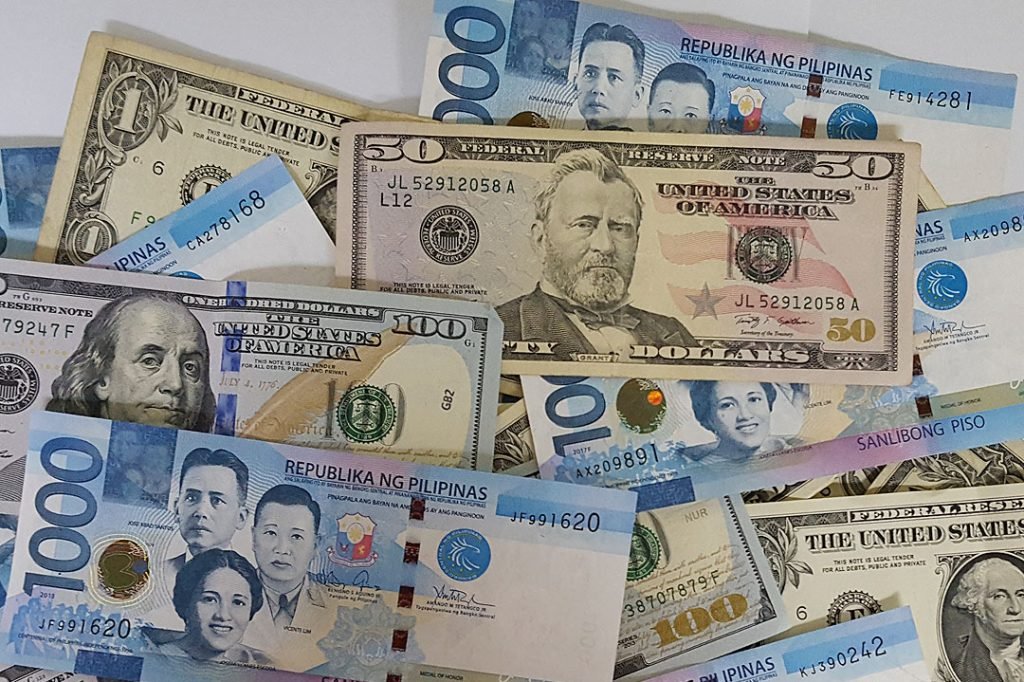
THE PESO could move sideways against the dollar this week as the market reacts to key US labor data released on Friday that boosted expectations of another rate cut by the US Federal Reserve this month.
The local unit closed at P57.735 per dollar on Friday, strengthening by 14.5 centavos from its P57.88 finish on Thursday, Bankers Association of the Philippines data showed.
This was the peso’s best finish in more than six weeks or since its P57.59 close on Oct. 21.
Week on week, the peso jumped by 88.5 centavos from its P58.62 finish on Nov. 29.
“The dollar weakened following the release of US initial jobless claims and local inflation,” a trader said by phone on Friday.
Philippine headline inflation picked up to 2.5% in November from 2.3% in October, the government reported last week.
Still, this was slower than the 4.1% print in the same month a year ago and was within the central bank’s 2.2%-3% forecast for the month.
For the first 11 months, headline inflation averaged 3.2% in the 11-month period, a tad faster than the BSP’s 3.1% full-year baseline forecast but well within its 2-4% annual goal.
Meanwhile, the number of Americans filing new applications for unemployment benefits rose slightly in the last week of November, pointing to steadily easing labor market conditions heading into the final stretch of 2024, Reuters reported.
Initial claims for state unemployment benefits rose 9,000 to a seasonally adjusted 224,000 for the week ended Nov. 30, the Labor department said on Thursday. Economists polled by Reuters had forecast 215,000 claims for the latest week.
The data included the Thanksgiving holiday, which could have injected some noise into the report. Claims are entering a period of volatility, which could make it difficult to get a clear picture of the labor market.
The peso also continued to be supported by the seasonal increase in remittances from overseas Filipino workers amid the holidays, Rizal Commercial Banking Corp. Chief Economist Michael L. Ricafort said in a Viber message.
For this week, the trader said the foreign exchange market will react to the US nonfarm payrolls (NFP) data released on Friday.
“Softer NFP figures may encourage dollar selling, while a surprisingly stronger NFP may push the dollar-peso to P58,” the trader said.
The trader sees the peso moving between P57.50 and P58 per dollar this week, while Mr. Ricafort expects it to range from P57.25 to P57.85.
US job growth surged in November after being severely hindered by hurricanes and strikes, but a rise in the unemployment rate to 4.2% pointed to an easing labor market that should allow the Federal Reserve to cut interest rates again this month, Reuters reported.
The labor market’s resilience is driving the economy through strong consumer spending, with the closely watched employment report from the Labor Department on Friday showing solid wage growth last month. The economy created 56,000 more jobs in September and October than previously estimated.
Nonfarm payrolls increased by 227,000 jobs last month after rising by an upwardly revised 36,000 in October, the Labor department’s Bureau of Labor Statistics said. Economists polled by Reuters had forecast payrolls would gain 200,000 jobs following a previously reported rise of 12,000 in October.
Job growth averaged 173,000 per month over the past three months.
Financial markets see a roughly 89% chance of a quarter-percentage-point rate cut at the US central bank’s Dec. 17-18 policy meeting, up from 72% earlier, CME Group’s FedWatch tool showed. The Fed has lowered interest rates by 75 basis points since September, when it launched its easing cycle. Its policy rate is now in the 4.50%-4.75% range, having been hiked by 5.25 percentage points between March 2022 and July 2023. — A.M.C. Sy with Reuters







